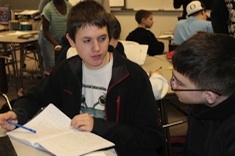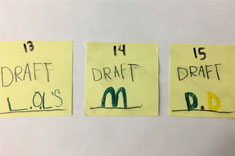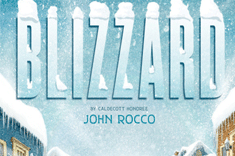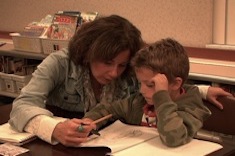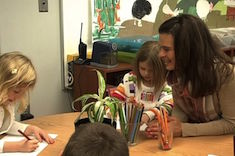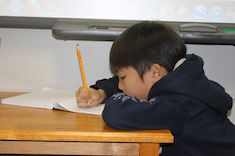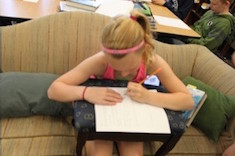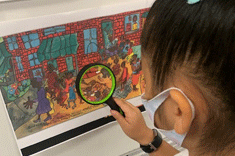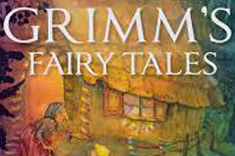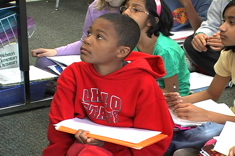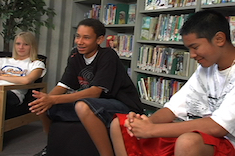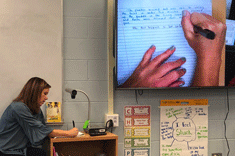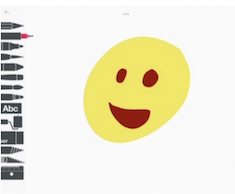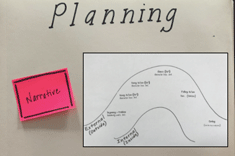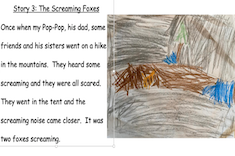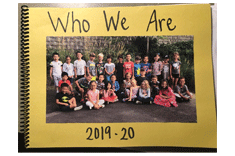Teaching Writing
Everyone who writes for Choice Literacy loves teaching writing, because we all write ourselves. We know it is "hard fun," as Donald Murray famously said—exasperating and exhilarating at the same time. The writing workshops you will read about here and see in our videos are busy, noisy, vibrant places. And most days, we wouldn't want to be anywhere else than in the midst of 'em! Here is where you'll find our latest discoveries, insights, and occasional boneheaded mistakes in teaching writing.
Latest Content
The Answer Is Always “Yes”
Julie Johnson shows how saying yes empowers students to do the work of writers: make decisions, experiment, build relationships, and be confident as a writer.
Five Phrases That Should Be at the Top of Every Writer’s First Draft
Matt Renwick gives five phrases every writer should put at the top of a draft, and then explores the way doing so can help develop creativity.
Austin Makes Writing Plans
In this video, Austin reads his writing and shares his next steps by self-recording a video to upload to the Learning Management System.
Helping Young Writers Make Plans
Tammy Mulligan promotes independence in her student writers by supporting them in creating writing plans. A download of a planning template is included so your students can create writing plans, too.
Ten Ways to Celebrate Writers
Jen Court gives 10 ways for students to share and celebrate their work as writers. Two downloads are included for you to use in your classroom.
Picture Books to Teach Conflict
Katherine Sokolowski shares a book list that inspires her to teach five different kinds of conflict.
Four Keys to Making Workshop Work
Bitsy Parks reminds us of four key components of running a workshop and offers advice for making workshop work.
Quick Take: Beware of Pet Peeves
Ruth Ayres cautions us to not let our pet peeves get in the way when working with student writers.
Reasons to Launch Writer’s Notebooks with Primary Writers
Mandy Robek shares keys to knowing when to launch writer’s notebooks with primary writers.
Supports for Our Youngest Writers
Cathy Mere identifies ways to support our youngest writers.
Combining Personal Narratives and Comics
Katherine Sokolowski combines personal narratives and comics to encourage students to go deeper in their storytelling.
Using Art to Bridge Storytelling
Stella Villalba creates space for students to deeply notice the way artist Aminah Robinson uses images to share stories and testimonies.
Where the Writing Carries Meaning
Ruth Ayres explains the way image, text, and sound work together to create meaningful writing. She helps us consider where the writing carries the most meaning, as well as how these modes work together.
Fairy Tales with a Multimodal Twist: Process and Product
In this second installment, Julie Johnson guides the process of creating multimodal fairy tales, as well as discusses producing the final product.
Fairy Tales with a Multimodal Twist: Laying the Groundwork
Julie Johnson outlines the groundwork for creating multimodal fairy tales in writing workshop.
Conventions and Keeping It Real
Melanie Quinn uses her fourth graders love of drama to create a fun activity for learning how to integrate quotations into writing.
Is Grammar-Check Cheating?
Gretchen Schroeder discusses grammar tools and the reasons students should use them as writers.
Editing to Consolidate
Jen Schwanke outlines ways to make substantial cuts to a draft in order to have confidence in the clarity of a message.
Crafting Argumentative Essays
Gretchen Schroeder shares a summative assessment inspired by Song Exploder in which her high school students craft an argumentative essay defending a choice of a great song.
Yoga Poses and Workshop Processes: Honor the Journey
Nawal Qarooni is inspired by her yoga practice to provide a guided reflection to consider if workshop practices are progressing to a transfer of learning.
How Pictures Can Engage and Inspire Writers
Melanie Meehan shows how pictures offer ways to expand access to students as writers by providing scaffolds and inspiration.
Writers’ Club
In her high school writing workshop, Julie Cox noticed that students wrote eagerly, but struggled to give and accept feedback. To increase student ownership and trust, she started Writers’ Club, and it affected transfer of learning in big ways!
Online Writing Notebooks
Gretchen Schroeder makes the leap to digital notebooks and finds new life in a tried-and-true practice.
COVID Silver Linings: Positive Changes in Teaching Practices
Dana Murphy outlines the teaching practices that she learned from remote teaching and plans to carry with her upon returning to a physical classroom.
Importance of Talk in Writing Workshop
Julie Johnson reminds us of important mindsets to adopt to allow students the space and permission to talk while composing. When students talk as writers, they have opportunities to create new understandings, build relationships, and validate each other.
Celebrating with Fan Fiction
Melanie Meehan shares how a short dip into fan fiction can be a wonderful way to inject some play and raise engagement in writing.
What Are You Celebrating Today?
Melissa Quimby leans in and asks her students to define their celebrations as writers. Rather than always naming the celebration for students, Melissa helps students gain ownership of the writing process by learning to celebrate every stage.
Tips for Creating Shared-Writing Texts Online
Tammy Mulligan offers tips for creating shared-writing texts online.
Class Books Build Readers, Writers, and Community
Bitsy Parks shares the ways in which class books help students work as readers and writers, as well as build a community.
Writing Joy: A Publishing Celebration
Bitsy Parks shares the celebration within the publishing process. Learn to find the joy in uplifting young writers’ approximations by sharing their works with a larger audience.
Browse Content By
Type
Category
- Assessment Tools
- Big Fresh Archives
- Booklists
- Choice Numeracy
- Classroom Design
- Common Core
- Community Building
- Conferring
- Content Literacy
- Digital Literacy
- English Language Learners
- Equity
- Family Relations
- Free Samples
- Guiding Groups
- Leadership
- Literacy Coaches
- Mentor Texts
- Minilessons
- New Teacher Mentors
- Podcasts
- Poetry
- Quote Collections
- Reading Strategies
- Self Care
- Struggling and Striving Learners
- Talking and Listening
- Teacher Study Groups
- Teaching Reading
- Teaching Writing
- Word Study and Vocabulary
Author
- Melissa Quimby
- Nawal Qarooni
- Gwen Blumberg
- Julie Cox
- The Lead Learners
- Hannah Tills
- Josie Stewart
- Ruth Metcalfe
- Mallory Messenger
- Becca Burk
- Jodie Bailey
- Vivian Chen
- Mary Brower
- Tiffany Abbott Fuller
- Stephanie Affinito
- Ruth Ayres
- Leigh Anne Eck
- Heather Fisher
- Shari Frost
- Julie Johnson
- Suzy Kaback
- Gigi McAllister
- Shirl McPhillips
- Melanie Meehan
- Cathy Mere
- Debbie Miller
- Tara Barnett and Kate Mills
- Tammy Mulligan
- Dana Murphy
- Bitsy Parks
- David Pittman
- Brenda Power
- Heather Rader
- Matt Renwick
- Mandy Robek
- Christy Rush-Levine
- Gretchen Schroeder
- Jen Schwanke
- Brian Sepe
- Katherine Sokolowski
- Stella Villalba
- Jennifer Vincent
Grade Level
Choice Literacy Membership
Articles
Get full access to all Choice Literacy article content
Videos
Get full access to all Choice Literacy video content
Courses
Access Choice Literacy course curriculum and training


